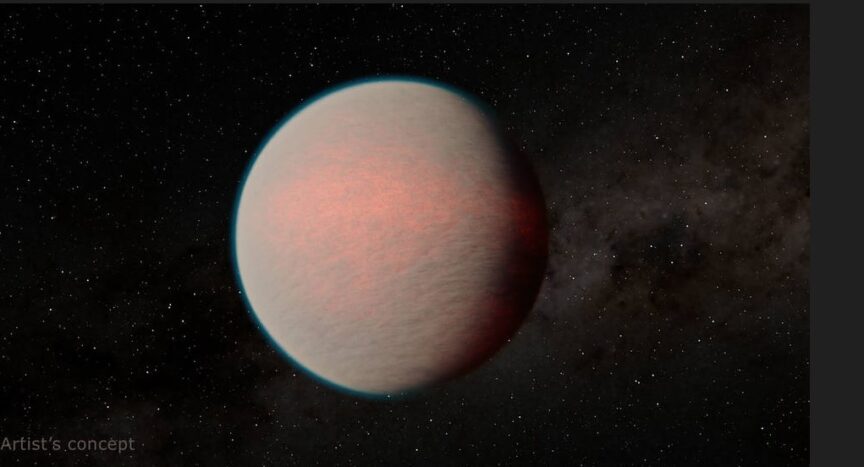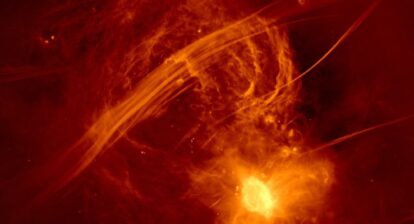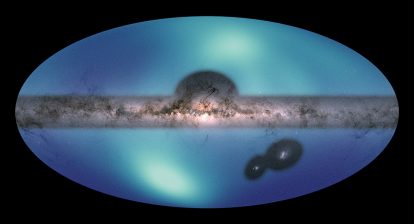A science team gains new insight into the atmosphere of a “mini-Neptune,” a class of planet common in the galaxy but about which little is known.
NASA’s James Webb Space Telescope has observed a planet far outside our solar system and has revealed a probably highly reflective world with a steamy atmosphere. This observation marks our closest look yet at a mysterious “mini-Neptune” that was not possible to observe previously.
The planet is called GJ1214 b and is too hot for liquid-water oceans to exist on it, however “water in vaporized form still could be a major part of its atmosphere”, said NASA in a statement.
“The planet is totally blanketed by some sort of haze or cloud layer,” said Eliza Kempton, a researcher at the University of Maryland and lead author of a new paper, published in Nature, on the planet. “The atmosphere just remained totally hidden from us until this observation.” She noted that, if indeed water-rich, the planet could have been a “water world,” with large amounts of watery and icy material at the time of its formation.
To penetrate its thick hazy atmosphere, the researches used two approaches: “In addition to making the standard observation – capturing the host star’s light that has filtered through the planet’s atmosphere – they tracked GJ 1214 b through nearly its entire orbit around the star.”
According to the stattement: “Using Webb’s Mid-Infrared Instrument (MIRI), the research team was able to create a kind of “heat map” of the planet as it orbited the star. The heat map revealed – just before the planet’s orbit carried it behind the star, and as it emerged on the other side – both its day and night sides, unveiling details of the atmosphere’s composition.”
“The ability to get a full orbit was really critical to understand how the planet distributes heat from the day side to the night side,” Kempton said. “There’s a lot of contrast between day and night. The night side is colder than the day side.” In fact, the temperatures shifted from 535 to 326 degrees Fahrenheit (from 279 to 165 degrees Celsius).
Such a big contrast is only possible when the atmosphere is made up of heavy molecules, such as those of water and methane.
“That means the atmosphere of GJ 1214 b is not composed mainly of lighter hydrogen molecules”, Kempton said, “which is a potentially important clue to the planet’s history and formation – and perhaps its watery start.”
“This is not a primordial atmosphere,” she said. “It does not reflect the composition of the host star it formed around. Instead, it either lost a lot of hydrogen, if it started with a hydrogen-rich atmosphere, or it was formed from heavier elements to begin with – more icy, water-rich material.”
It is also Cooler Than Expected
Although hot by our own human standards, it is much cooler than expected beause of its unusually shiny atmosphere that reflects away a large fraction of light from its star, rather than absorbing its heat.
These brilliant new observations with the help of Webb are a step forward towards deeper knowledge of such mysterious mini-Neptunes (called sub-Neptunes in the paper). They are the most common type of planet in our Milky Way galaxy but remain mysterious because there are none to be found in our solar system. Their measurements indicate that they are somewhat similar to a downsized version of our planet Neptune but other than that we don’t know much.
“For the last almost decade, the only thing we really knew about this planet was that the atmosphere was cloudy or hazy,” said Rob Zellem, an exoplanet researcher who works with co-author and fellow exoplanet researcher Tiffany Kataria at NASA’s Jet Propulsion Laboratory in Southern California. “This paper has really cool implications for additional detailed climate interpretations – to look at the detailed physics happening inside this planet’s atmosphere.”
The new study suggests that GJ1214 b may have formed farther away from its parent star (a red dwarf), then spiraled gradually inward till it reached its current position and orbit. Its year – one orbit around the star – takes only 1.6 Earth days.
“The simplest explanation, if you find a very water-rich planet, is that it formed farther away from the host star,” Kempton said.
Of course, further observations will be needed to garner more information about GJ1214 b and other such mini-Neptunes.
“By observing a whole population of objects like this, hopefully we can build up a consistent story,” Kempton said.







